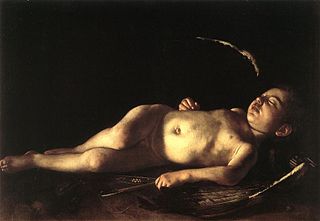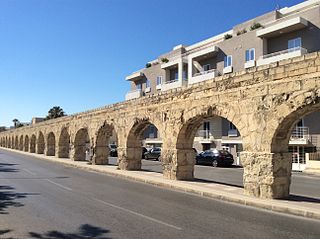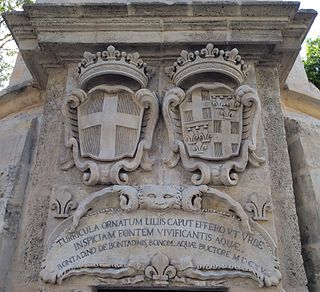
Michelangelo Merisi da Caravaggio, known mononymously as Caravaggio, was an Italian painter active in Rome for most of his artistic life. During the final four years of his life, he moved between Naples, Malta, and Sicily until his death. His paintings have been characterized by art critics as combining a realistic observation of the human state, both physical and emotional, with a dramatic use of lighting, which had a formative influence on Baroque painting.

Fra Alof de Wignacourt was a French nobleman who was the 54th Grand Master of the Order of St. John of Jerusalem from 10 February 1601 to his death in 1622. Unlike a number of the other Grand Masters, he was popular with the Maltese people. Wignacourt is mostly remembered for the construction of the Wignacourt Aqueduct as well as a series of coastal towers which also bear his name.

St John's Co-Cathedral is a Roman Catholic co-cathedral in Valletta, Malta, dedicated to Saint John the Baptist. It was built by the Order of St. John between 1573 and 1578, having been commissioned by Grand Master Jean de la Cassière as the Conventual Church of Saint John.

Wignacourt Tower, also known as Saint Paul's Bay Tower, is a bastioned watchtower in St. Paul's Bay, Malta. It was the first of six Wignacourt towers to be built, and the first stone was laid on 10 February 1610. It replaced the role of Ta' Tabibu farmhouse which was previously known as Dejma Tower. An artillery battery was added a century later in 1715. Today the tower is a museum of fortifications around the Maltese Islands.

Xgħajra is a small village in the South Eastern Region of Malta. It is located on the coast, about halfway between Valletta and Marsaskala. Its local football club is known as the Xgħajra Tornadoes F.C. Contrary to popular belief, it has no relation to the Gozitan village Xagħra. Its population stood at 1,732 in March 2014.

Portrait of a Courtesan was a painting by the Baroque master Michelangelo Merisi da Caravaggio. Painted between 1597 and 1599, it was destroyed in Berlin in 1945 and is known only from photographs. It has been suggested that the portrait represents the goddess Flora.
John the Baptist was the subject of at least eight paintings by the Italian Baroque artist Michelangelo Merisi da Caravaggio (1571–1610).

Sleeping Cupid is a painting by the Italian master Caravaggio. Unlike many of Caravaggio's works, it can be dated accurately. It was commissioned for Fra Francesco dell'Antella, Florentine Secretary for Italy to Alof de Wignacourt, Grand Master of the Knights of Malta, and an old inscription on the back records that it was painted in Malta in 1608.

Salome with the Head of John the Baptist (Madrid), c. 1609, is a painting by the Italian master Caravaggio in the Royal Collections Gallery, Madrid.

Saint Jerome Writing is a painting by the Italian master Michelangelo Merisi da Caravaggio in 1607 or 1608, housed in the Oratory of St John's Co-Cathedral, Valletta, Malta. It can be compared with Caravaggio's earlier version of the same subject in the Borghese Gallery in Rome.

Portrait of Alof de Wignacourt with his Page is a painting by the Italian master Caravaggio, in the Louvre of Paris.

Fra' Adrien de Wignacourt was the 63rd Prince and Grand Master of the Order of Malta from 1690 to 1697.
Events from the year 1608 in art.

Santa Maria delle Grazie Tower, also known as Delle Grazie Tower, Madonna delle Gratie Tower or Blata Bajda Tower, was a watchtower in what is now Xgħajra, Malta. It was constructed in 1620, and was the last of six Wignacourt towers to be built. The tower was demolished in the late 19th century by the British military.

The Beheading of Saint John the Baptist is an oil painting by the Italian artist Caravaggio. Measuring 3.7 m by 5.2 m, it depicts the execution of John the Baptist. It is located in the Oratory of St. John's Co-Cathedral in Valletta, Malta.
Wignacourt is a surname. Notable people with the surname include:

The Wignacourt Aqueduct is a 17th-century aqueduct in Malta, which was built by the Order of Saint John to carry water from springs in Dingli and Rabat to the newly built capital city Valletta. The aqueduct carried water through underground pipes and over arched viaducts across depressions in the ground.

Garzes Tower, also known as Saint Martin's Tower, was a watchtower built in Mġarr, Gozo by the Order of Saint John in 1605. It was named after Martin Garzez, the Grand Master who financed its construction, even though it was eventually built after his death during the Magistry of Alof de Wignacourt. The tower was demolished in the 19th century, some remains were reused for the building of a bridge, and the site was developed with a hotel.

The Wignacourt Museum is a museum in Rabat, Malta. It is housed in an 18th-century Baroque building which housed the Chaplains of the Order of St. John, and it is named after Grand Master Alof de Wignacourt, who ruled over the Maltese Islands between 1601 and 1622.

Vittorio Bontadini, better known as Bontadino de Bontadini, was a Bolognese hydraulic engineer, architect, mathematician and wood carver. He is mostly known for designing the Wignacourt Aqueduct in Malta.

















